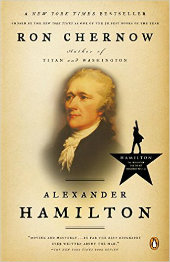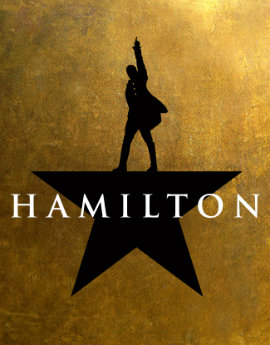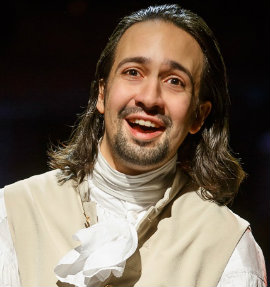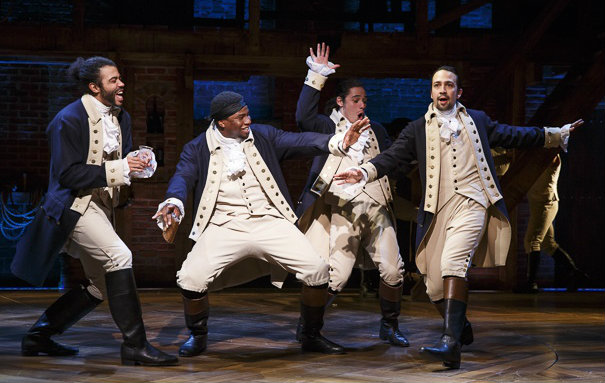Hamilton on Broadway: History With a Beat
A MiddleWeb Blog

This is a wonderful opportunity for history students to be able to connect to the past in a contemporary context and to become engaged with the content they are studying in an exciting way. We’d like to see it, we would LOVE to take our students to see it…but…we are in California.
So the next best thing is that we can use it in our classrooms. To quote Jimmy Fallon in a conversation with Lin-Manuel Miranda (Hamilton’s creator and star actor): “How many history teachers are like, ‘This is the greatest thing ever?!’” We are, Jimmy. We are.
While some educators might approach this musical with a raised eyebrow for a number of reasons, it really does pay off. Historically, if accuracy is 
And to those who might think a musical about the lives of the founders might be a bit dry, Miranda has infused his retelling of history with hip-hop, rap, and pop, and has given life to a story that, for many, has been difficult to relate to in the modern era.
Moreover, Miranda’s historically valid choice to emphasize Hamilton’s status as an immigrant wanting to make a name for himself in his adopted country has made the story even more relatable to students today.
“The ship is in the harbor now, see if you can spot him, another immigrant, comin’ up from the bottom. His enemies destroyed his rep. America forgot him.”
from CBS Sunday Morning
Some concerns about explicit dialogue and lyrics
The themes that ring out in the show are arguably more important than the specifics of the actual history presented as they are the contextualizing anchors that bring in the listener/audience, make the history relatable, and bring the rawness of the characters in the American Revolution and the first throes of America’s governance to the forefront in a visceral way.
“I’m just like my country, I’m young scrappy and hungry, and I’m not throwing away my shot,” says Hamilton in a theme that repeats throughout the show. And for those who know the end of this story, this ambitious line has a haunting foreshadowing.

Beyond the Explicit Language
If it’s possible for your school, do what you can to get around this; the music is worth it. The language, while problematic in some ways, allows students get to know characters from history on a more personal level, and using today’s vernacular, as well as a more musically accessible format, allows students to relate more than ever. This applies to all the language used in the show, not just the explicit language, though the explicit language is likely more historically accurate than we imagine.
Students will find not just the language accessible, but also the way that the songs present content. For example, in our classrooms we have always taught that the Declaration of Independence was like America’s breakup letter with England, which puts the events in terms that middle schoolers relate to well. Hamilton takes it up a notch and has England respond to America’s declaration as a controlling, scorned lover might.
The theme of who tells the story – who “owns” the narrative – is another that follows throughout the show. The casting of actors of color as Washington, Hamilton, Jefferson, Burr, Lafayette, Angelica Schuyler, and Madison to name just a few, is a way of taking back the narrative. Miranda also reminds the audience of the plight of the slaves while dealing with the major players of the dominant narrative (Hamilton was an abolitionist and therefore this theme is historically accurate as well).
Encountering America’s Contradictions
As history teachers, we have had a struggle to reconcile teaching that this country was founded upon principles of freedom and equality while knowing that people of color, women, and the poor did not have a voice at America’s inception. Hamilton does not shirk from acknowledging the underrepresented populations yet also presents a proud history that celebrates the ideals of this country. It is challenging to find resources that achieve this.
To hear the lyrics that were actually spoken at the time – from primary sources – in this context is both jarring and moving. George Washington, lamenting his lack of supplies, men, and money, sings/speaks “Are these the men with which I am to defend America?”, a sentiment he uttered during the Landing at Kip’s Bay.Parts of Washington’s Farewell Address, written with/by Hamilton, are repeated word for word. The history we want our students to understand – the attenuation of the British army in the success of the Revolution, Lafayette and the French’s role in the victory, the purpose of the Federalist Papers, cabinet meetings that deal with America’s financial future, as well as a rousing song about the closed-door deal that resulted in moving the capital to the Potomac – are all rendered in the most attention grabbing, most vibrant way possible.
This is a current and exciting opportunity to be able to make our students connect with history, to help bring it to life. And we’re holding our breath until the show comes to California.



![1024px-Alexander_Hamilton trumbull 270 | MiddleWeb John Trumbull [Public domain], via Wikimedia Commons](https://www.middleweb.com/wp-content/uploads/2015/11/1024px-Alexander_Hamilton-trumbull-270.jpg)



































This is amazing! How do I (and how did you all) view the musical without going to NYC? Is there a recording somewhere for sale?! I MUST get ahold of this.
Well, we haven’t SEEN it, but we’ve watched every clip available on YouTube. Our main entry into the world of the show has been the soundtrack which is available on Atlantic Records through iTunes or streaming if you’ve got Amazon Prime; it is worth it for sure.
I’ll check out the soundtrack. It’d be great if someone would start producing videos for sale!
I just purchased the soundtrack. How are you ladies using it in the classroom? I’m trying to put together a lesson plan beyond simply listening to the tracks. I found an article on the New York Times site that might lead to something interesting. Would love to hear more about what you did in your classroom.
Thank you so much for reading and commenting, Christine. How to use it really depends on where you are in your curriculum.
When Shara first listened to the soundtrack her students had just finished their Revolutionary War unit and were about to learn about the Articles of Confederation and the Constitution. The song “What Comes Next” was perfect as an anticipatory set–it’s a fictional yet plausible response from Britain to America at the conclusion of the Revolutionary War. They listened to the song while reading the lyrics at the beginning of class, and she asked the students what group the singer represented and to whom was he directing his message. They then annotated the song looking for references to content they had already learned (“the price of my war” referring to costs incurred from the French and Indian War, “you cheat with the French” referring to France aiding the rebelling colonists, etc). Then as a class, the students predicted what kind of government the colonists would want to create given their recent experiences with the British, leading into a lesson on the Articles of Confederation. It was a convenient bridge from one concept to the next.
Jody so far has used King George’s “You’ll Be Back” to discuss the Declaration of Independence as a break up letter with Britain before delving into the text itself. Before their Revolutionary War battle simulation, the students also listened to “Right Hand Man,” “Stay Alive,” and “Guns and Ships” to discuss the Continental Army’s inferiority and difficulties, and the differences between the fighting styles.The songs discuss strategies to be able to make it “impossible to justify the cost of the fight” and the importance of French aid in the winning of the war which helped to augment readings and discussion after the simulation. With any song with explicit content, Jody skipped over the particular part.
We haven’t yet written lessons around the songs themselves, but rather used them to augment lessons that we had already.
In the future, there is a great deal we will be able to do with the Federalist Papers and the conflicts about the National Bank between the Federalists and Democratic Republicans— we are looking forward to it! Please let us know if you end up creating a lesson around any of the songs— we’d love to hear about it.
I am working on a lesson on Hip Hop from reading a short essay by Efrem Smith with my ELL students. The essential question from the students was, What is Hip Hop? They had many answers to this question: more than music, more than the bad language in rap, more than fashion, more than commercials using the rap beat. etc…So they asked, Where did Hip Hop come from and why? This has led them to be engaged because many of my students are immigrants or come from first generation immigrant parents and they relate to the feelings of being ignored, demeaned, and frustrated.
After watching the Grammy’s Sunday and learning about Hamilton the musical, I had them watch a clip from the show and the interview above with Lin-Manuel Miranda. I first asked someone to take out a $10 bill and asked them who was on it. A few knew the name but didn’t know his full story.
Students are now working on their own group projects to share what they have learned about Hip Hop and to share it with the rest of the student population. The class will determine the best way to share; Facebook page, Twitter page, or a blog. They are working on a timeline, posters, Google slide presentation, etc..
This fusion of history and rap was a great addition to our lesson on Hip Hop!!!
Can’t wait for the show to travel to other cities and for a “clean” soundtrack that I can share with the students.
Yes yes yes! To everything in this post. I have been showing the White House version for years and kids were so excited by that alone and were constantly requesting to watch it again and again. I had kids going home and memorizing it, for fun! So, needless to say, we were beyond excited that the musical was written and such a hit. I am using the lyrics from the show this year to go along with the content we are teaching and just doing some basic editing (as in turn the volume down and then back up, very high tech, I know) For example, we listened to the two rap battles/cabinet meetings and read along with the lyrics, I just blacked out the explicit lyrics and did my high tech editing. This show has added a whole other awesome layer to learning about history and makes it so accessible to my kids. My students are doing a March Madness bracket contest of historical events from this era and have to do presentations. A few of them are putting songs in from the show to add to their content. And yes, Jimmy Fallon, we are pumped!! BTW- I love your blog- you two are my history teacher spirit animals.
Erin, thank you so much for reading and being a loyal follower of the Future of History blog; history teachers have to stick together!
Love hearing how you are teaching Hamilton– what program did you use to edit out the language in the Cabinet Battles? Both have such good historical material in them to discuss and to help contextualize American history.
Ha- my high tech editing program was to use a black sharpie on the lyrics and turn my speaker down and then back up :)